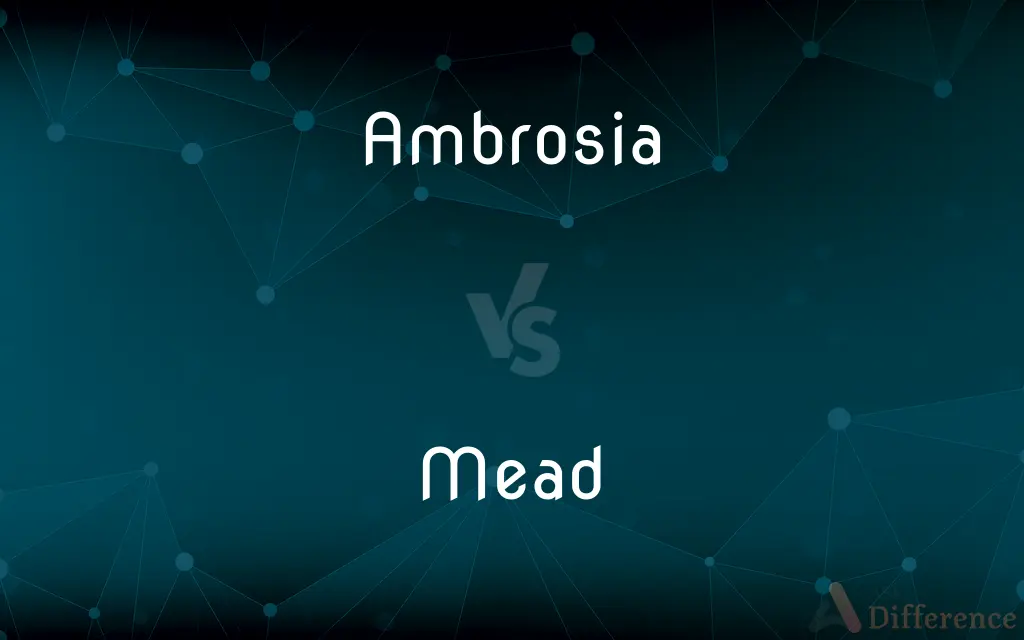Ambrosia vs. Mead — What's the Difference?
Edited by Tayyaba Rehman — By Maham Liaqat — Updated on April 20, 2024
Ambrosia is a mythical food of the Greek gods, often associated with immortality, while mead is a historical alcoholic beverage made from fermented honey and water.

Difference Between Ambrosia and Mead
Table of Contents
ADVERTISEMENT
Key Differences
Ambrosia is depicted in ancient Greek mythology as the food or drink of the Olympic gods that conferred longevity or immortality, highlighting its divine and mythical nature. Mead, on the other hand, is a real-world alcoholic drink that has been consumed by various cultures throughout history, particularly noted for its presence in ancient European rituals.
The ingredients of ambrosia are not consistently described in myths, sometimes portrayed as a mixture of honey, water, and fruit, but always with magical or supernatural qualities. Whereas mead is specifically made from honey, water, and sometimes yeast, with variations including the addition of fruits, spices, or grains to enhance flavor.
Ambrosia plays a symbolic role in literature and art, often representing divine sustenance that is beyond the reach of mortals. Mead, however, has been a popular drink in social and ceremonial contexts, appreciated for its sweet taste and the ease with which it can be made.
The consumption of ambrosia is restricted to the gods in myths, reinforcing themes of power and exclusivity. Mead has been accessible and enjoyed by a wide range of people from different social strata, from ancient times to modern craft beverage movements.
While ambrosia is purely mythical and does not impact the physical world, mead has had tangible cultural and economic impacts, influencing brewing traditions and alcohol commerce in various historical periods.
ADVERTISEMENT
Comparison Chart
Nature
Mythical substance
Alcoholic beverage
Ingredients
Varied, often includes honey; mystical elements
Honey, water, sometimes yeast; may include fruits
Significance
Symbolizes immortality and divine status
Historical and cultural significance in many societies
Accessibility
Exclusive to deities in mythology
Widely available and consumed by humans
Impact
Symbolic, featured in stories and art
Economic and social impacts through history
Compare with Definitions
Ambrosia
The food or drink of the gods in Greek mythology, believed to confer immortality.
Ambrosia was often depicted in ancient art as being served at divine banquets.
Mead
Often referred to as "honey wine" due to its sweet base.
They sampled several types of mead at the medieval fair.
Ambrosia
A term used metaphorically to refer to something very pleasing to taste or smell.
The chef's signature dish was nothing less than ambrosia.
Mead
Can be flavored with fruits, spices, or herbs to create different varieties.
The brewer experimented with adding cinnamon to the mead.
Ambrosia
Rarely, a type of dessert made from cream and fruits.
For dessert, they served a tropical ambrosia with mangoes and pineapples.
Mead
Enjoyed by many for its unique and rich flavor.
At the tasting, everyone appreciated the rich complexity of the homemade mead.
Ambrosia
Used in literature as a symbol of divine or unearthly pleasure.
The poet described the scent of the blooms as ambrosia.
Mead
An alcoholic drink made by fermenting honey with water.
Mead has been enjoying a resurgence among craft beverage enthusiasts.
Ambrosia
Associated with rituals and celebrations in mythological contexts.
Ambrosia was prepared during the festival honoring the gods.
Mead
Historical importance in ceremonies and rituals, especially in Norse culture.
Mead was central to the Viking feasts and toasts.
Ambrosia
In the ancient Greek myths, ambrosia (, Ancient Greek: ἀμβροσία 'immortality') is the food or drink of the Greek gods, often depicted as conferring longevity or immortality upon whoever consumed it. It was brought to the gods in Olympus by doves and served by either Hebe or Ganymede at the heavenly feast.Ambrosia is sometimes depicted in ancient art as distributed by a nymph labeled with that name and a nurse of Dionysus.
Mead
Mead (), or fermented honey water, is an alcoholic beverage, sometimes with various fruits, spices, grains, or hops. The alcoholic content ranges from about 3.5% ABV to more than 18%.
Ambrosia
Greek & Roman Mythology The food of the gods, thought to confer immortality.
Mead
An alcoholic beverage made from fermented honey and water.
Ambrosia
Something with an especially delicious flavor or fragrance.
Mead
A meadow.
Ambrosia
A dessert of mixed fruits, usually including oranges and pineapple, combined with flaked coconut and often marshmallows.
Mead
An alcoholic drink fermented from honey and water.
Ambrosia
The food of the gods, thought to confer immortality.
Mead
(US) A drink composed of syrup of sarsaparilla or other flavouring extract, and water, and sometimes charged with carbon dioxide.
Ambrosia
The anointing-oil of the gods. Category:en:Immortality
Mead
(poetic) A meadow.
Ambrosia
Any food with an especially delicious flavour or fragrance.
Mead
A fermented drink made of water and honey with malt, yeast, etc.; metheglin; hydromel.
Ambrosia
Anything delightfully sweet and pleasing.
Mead
A drink composed of sirup of sarsaparilla or other flavoring extract, and water. It is sometimes charged with carbonic acid gas.
Ambrosia
An annual herb historically used medicinally and in cooking, Dysphania botrys.
Mead
A meadow.
A medeAll full of freshe flowers, white and reede.
To fertile vales and dewy meadsMy weary, wandering steps he leads.
Ambrosia
A mixture of nectar and pollen prepared by worker bees and fed to larvae.
Mead
United States philosopher of pragmatism (1863-1931)
Ambrosia
Any fungus of a number of species that insects such as ambrosia beetles carry as symbionts, "farming" them on poor-quality food such as wood, where they grow, providing food for the insect.
Mead
Made of fermented honey and water
Ambrosia
A dessert made of shredded coconuts and tropical fruits such as pineapples and oranges; some recipes also include ingredients such as marshmallow and cream.
Ambrosia
The fabled food of the gods (as nectar was their drink), which conferred immortality upon those who partook of it.
His dewy locks distilled ambrosia.
Ambrosia
A perfumed unguent, salve, or draught; something very pleasing to the taste or smell.
Ambrosia
Formerly, a kind of fragrant plant; now (Bot.), a genus of plants, including some coarse and worthless weeds, called ragweed, hogweed, etc.
Ambrosia
The food of certain small bark beetles, family Scolytidæ believed to be fungi cultivated by the beetles in their burrows.
Ambrosia
A dessert made from shredded coconuts and oranges, sometimes including other ingredients such as marshmallow.
Ambrosia
A mixture of nectar and pollen prepared by worker bees and fed to larvae
Ambrosia
Any of numerous chiefly North American weedy plants constituting the genus Ambrosia that produce highly allergenic pollen responsible for much hay fever and asthma
Ambrosia
Fruit dessert made of oranges and bananas with shredded coconut
Ambrosia
(classical mythology) the food and drink of the gods; mortals who ate it became immortal
Common Curiosities
What does ambrosia taste like?
Ambrosia's taste is mythical and not described specifically, often imagined as perfectly suiting the tastes of the gods.
Is ambrosia real?
Ambrosia is a mythical concept with no real-world counterpart, purely existing in stories and artistic depictions.
Can humans consume ambrosia?
In mythology, ambrosia is typically reserved for gods, though some stories feature mortals partaking in special circumstances.
Was ambrosia ever used in religious practices?
In myths, ambrosia was used in the rituals of the gods themselves, symbolizing their immortality and power.
Where did the idea of ambrosia originate?
The concept of ambrosia originates in ancient Greek mythology, associated with the stories of the Olympian gods.
How does mead compare to beer or wine?
Mead is similar to wine in terms of fermentation process but uses honey as a base, unlike beer which is grain-based.
What are the different types of mead?
Types of mead include traditional mead, melomel (fruited mead), metheglin (spiced mead), and cyser (apple mead).
How was ambrosia portrayed in ancient art?
Ancient art depicts ambrosia in scenes of divine life, often showing gods dining.
How is mead made?
Mead is made by fermenting a mixture of honey, water, and sometimes yeast, which can be flavored with various additives.
Can mead be used in cooking?
Yes, mead can be used in cooking, particularly in recipes that benefit from its sweet and complex flavor profile.
Is mead popular today?
Mead has gained popularity in modern times, especially among craft beverage enthusiasts and in historical reenactment communities.
What are the health benefits of mead?
Mead can have probiotic qualities due to fermentation, and the antioxidants in honey may confer some health benefits.
Share Your Discovery

Previous Comparison
Hemocyanin vs. Hemoglobin
Next Comparison
Bohemian vs. GypsyAuthor Spotlight
Written by
Maham LiaqatEdited by
Tayyaba RehmanTayyaba Rehman is a distinguished writer, currently serving as a primary contributor to askdifference.com. As a researcher in semantics and etymology, Tayyaba's passion for the complexity of languages and their distinctions has found a perfect home on the platform. Tayyaba delves into the intricacies of language, distinguishing between commonly confused words and phrases, thereby providing clarity for readers worldwide.














































